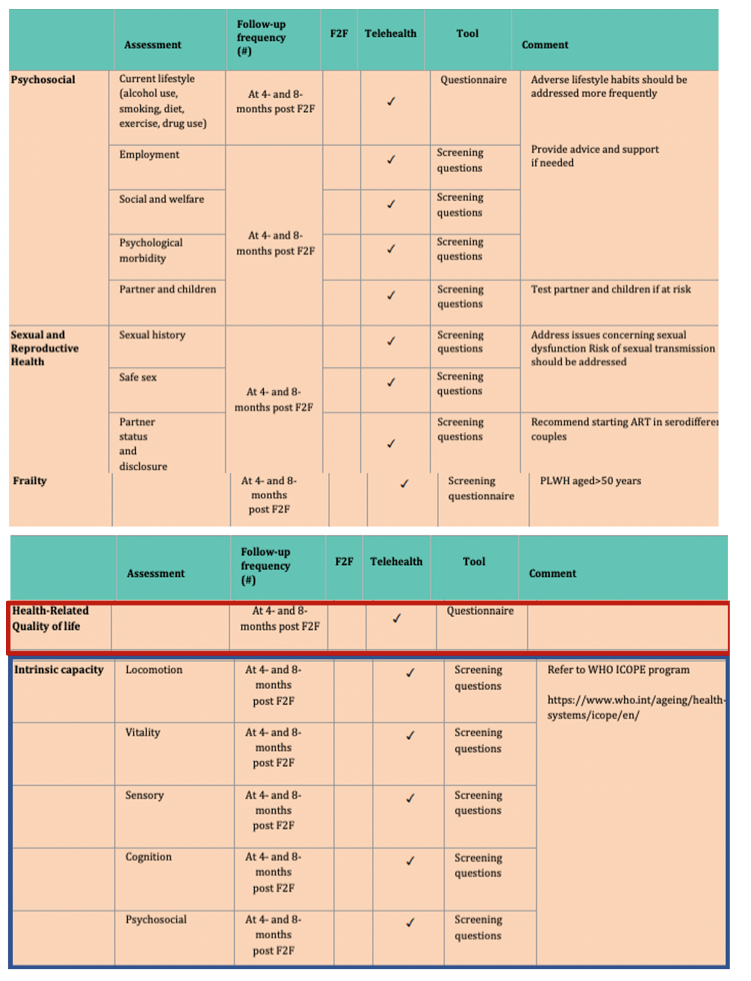| |
COVID Impact on Older HIV+ / Quality of Life NOT Viral suppression Is Endpoint !!!!
|
| |
| |
Download the PDF here
Study to evaluate Impact of COVID on Older PLWH
"The management of older PLHIV presenting with multimorbidity and frailty has led to the recognition that viral suppression is not the only endpoint of HIV care, resulting in the development of a "fourth 90" target [17]. The fourth 90 target aims to have 90% of people living with HIV having a good HRQoL. CID Dec 2020......
The Study was conducted from June 2020 thru Jan 2021. Frailty & resilience was evaluated as well as the impact on quality of life, depression, anxiety, and stress. And other mental & functional capacities.79% were found to be non-resilient - the average age was around 55 - females appear to perhaps to fare worse. Duration of having HIV appears to have an affect. Loneliness was found to have an affect. The authors used electronic surveys & recommend care providers do the same to evaluate the more vulnerable older HIV+ & to use health interventions for this older more vulnerable older HIV+ group, they suggest Telehealth can be used to provqidethe cars & interventions needed.
Healthy aging 80% Non Resilient Now During COVID / Isolation - Resilience and frailty in people living with HIV during the COVID era: two complementary constructs? - (02/09/21)
Separately, European & EACS leasers in HIV care & research - In Dec 2020 CID publication: "HIV care models during the COVID-19 era" - authors summarize & recommend a new model of care: using Telehealth to evaluate PLWH needs
HIV care during the COVID-19 pandemic requires changes in healthcare delivery. The use of telemedicine, for example, can help compensate for the reduction in face-to-face patient-physician encounters and accelerate a new HIV care model A patient-centered health model could utilize telemedicine, which has been used increasingly during the pandemic and offers new research opportunities and the possibility of redesigning previous models of care.
Overall, the follow-up time schedule suggests two to three patient-physician encounters each year, alternating one F2F meeting and one or two subsequent telephone/video calls 4-6 months apart. Some health data could be obtained both with telehealth and F2F.
Authors: Giovanni Guaraldi1, Jovana Milic1,2, Esteban Martinez3, Adeeba Kamarulzaman4, Cristina Mussini1, Laura Waters5, Anton Pozniak6, Patrick Mallon7, Jürgen Rockstroh8, Jeffrey V Lazarus9

"The management of older PLHIV presenting with multimorbidity and frailty has led to the recognition that viral suppression is not the only endpoint of HIV care, resulting in the development of a "fourth 90" target [17]. The fourth 90 target aims to have 90% of people living with HIV having a good HRQoL. Given that many PLHIV experience multimorbidity and frailty, which may have worsened during the pandemic, medical care should no longer focus primarily on "disease" *18+ but be broadened to an outcome perspective that also addresses quality of life (QoL) and healthy living with HIV. Incorporating patient-reported outcomes (PROs) to routinely assess HRQoL provides a measure of symptom severity and patients' functional and social capacities associated with healthcare or treatment [19]. HIV care must move beyond viral-immunological success to incorporate patient-centered outcomes based on the intrinsic characteristics of the individual and their environment [20]. Care should take into account the mental and physical health complexes as well as social challenges of each patient to tailor care to their needs. Furthermore, service redesign should be oriented around the diverse needs of individuals, rather than the prerequisites of providers, and must ensure health equity. In particular, any changes to care delivery must address existing disparities in access and care among vulnerable populations to enhance care. Realizing the promise of telehealth requires an understanding of how telemedicine can contribute to the full care spectrum, including data collection, patient empowerment, diagnosis, and therapy provision. telemedicine should not be limited to those providing HIV medical services but should comprise other healthcare professionals involved in HIV care such as nurses, psychologists, pharmacists, and other medical specialists that provide diagnostic and exploratory procedures. To optimize care delivery, telemedicine should be combined with the traditional F2F patient- physician encounter, which is often considered essential at the time of HIV diagnosis.
Absent in the original EACS table on "Assessment of PLHIV at Subsequent Visits" is the operationalization of healthy aging through intrinsic capacity as a new HIV care outcome, as suggested by the WHO Guidelines on Integrated Care for Older People (ICOPE) [22]. Healthy aging is defined by WHO as the process of developing and maintaining the functional ability that enables well-being in older age [23]. This construct derives from the relationship of two entities: (i) intrinsic capacity, which is the composite of all cognitive and physical functioning of the individual; and (ii) their environment. Healthy aging is particularly important for HIV since PLHIV face more age-related physical and mental health comorbidities compared to those without HIV. As such, it is critically important to monitor chronic conditions and indicators related to aging in PLHIV.
|
|
| |
| |
|
|
|